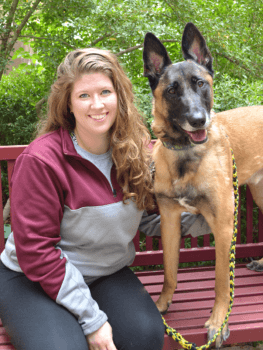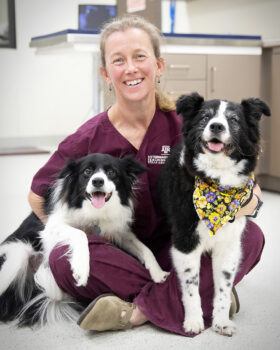Texas A&M Veterinarians Developing Frailty Instrument To Personalize Canine Geriatric Care

In human medicine, the ability to measure frailty is a vital aspect of geriatric care. Doctors may recommend one treatment over another based on an elderly person’s frailty score, and nursing homes may adjust care protocols as frailty increases.
While the ability to measure frailty is not a new concept in human medicine, it has previously been incorporated into veterinary medicine only in research and laboratory settings.
Soon, however, frailty will be an important consideration in caring for pets as well, thanks to the Dog Aging Project, a collaborative program led by the Texas A&M School of Veterinary Medicine & Biomedical Sciences (VMBS) and the University of Washington School of Medicine.
By working with tens of thousands of dog owners across the United States, the Dog Aging Project is creating a frailty instrument that can be used to make health decisions and personalize geriatric veterinary care for dogs of all shapes and sizes.
In an article recently published in Frontiers in Veterinary Science, the project’s veterinary team laid out its plan for developing the instrument by using a variety of simple tests and questionnaires that can be performed by dog owners and veterinarians.
“Dogs are living longer and longer because of the improving health care system and better nutrition,” said Dr. Rachel Melvin, a Dog Aging Project research team member and VMBS clinical trials intern. “We now have a bunch of old dogs whose owners want to do the best by them, and frailty scores help us do that by improving the personalized veterinary care those dogs receive.”
What Is Frailty?
Frailty is a complex syndrome associated with aging. Because it considers physical, mental and emotional changes associated with aging, it is a better indicator of the body’s condition and overall health than age by itself.
“Age is just a number, but it is a number that can carry a lot of baggage,” Melvin said. “Frailty is a way for us to measure aging more accurately, which we only could measure with years before.
“The higher their frailty score, the more likely a person is to fall down, need to be hospitalized, or to have complications while in a hospital,” she said. “Likewise, a dog with a higher frailty score may be more at risk for complications after surgery and take longer to recover than a less-frail dog.”
Frailty is especially important in veterinary medicine because dogs can vary greatly in size depending on their breed.
“A 12-year-old Great Dane and a 12-year-old Chihuahua are two vastly different animals in terms of health and body condition,” Melvin said. “Knowing a dog’s frailty score helps us measure and explain things like prognosis to owners, which then helps with making medical decisions.”
How To Measure Frailty

Turning an objective description of health into a numerical score is a challenging concept that requires finding tests or measurements that are indicative of an individual’s risk of death.
“In human medicine, grip strength is one common measurement used because losing strength is a good indication that your body is aging,” Melvin said. “In dogs, it gets a little more difficult because we can’t ask them to do a simple, repeatable task like gripping something. So, our surveys will have lots of questions that correlate with some of the common measurements used in human frailty scales.”
To begin the process, Melvin and her colleagues are considering many measurements that will be narrowed down once the team determines which are the most indicative of frailty.
Some of the factors being considered include body condition score, thigh girth deterioration, unintentional weight loss, gait speed, ability to climb stairs and willingness to participate in customary activities, like going on walks.
“We’re very passionate about the idea that these are simple, easy measurements that don’t require blood work or diagnostic tests,” Melvin said. “We want everyone to be able to know if their dog is frail without there being a cost or technical limitation.”
In addition to physical measurements, the surveys will include questions that cover the mental and emotional changes associated with aging.
“In human medicine, they’ve found that including psychological and social domains can lead to a more sensitive scale,” Melvin said. “There are lots of ways that the body manifests frailty beyond physical changes, and we want to make sure we cover every category.”
Some of the non-physical measurements being considered are a dog’s short-term memory, recall of learned behaviors, general anxiety and social avoidance. These would be measurable with simple tests and based on an owner’s interpretation of their dog’s behavior.
What The Scale Will Look Like
Once the team has narrowed down the questions that most effectively determine a dog’s frailty, they will develop a numerical frailty scale that general veterinary practitioners can use. After that, they plan to expand the scale into a full Frailty Instrument for Dogs (FIDo) to increase its usefulness in real-life situations.
“Our plan is to develop a three-tiered frailty instrument,” Melvin said. “There will be a screening portion with questions for the owner, a scale for general practitioners and a triage scale for emergency veterinarians and specialists. They won’t be interchangeable; they will be designed to work together.”
Especially in an ER setting, knowing a dog’s frailty score will help manage owner expectations and ensure that the medical decisions being made accurately consider the dog’s prognosis and quality of life.
Ultimately, measuring frailty is an important part of the Dog Aging Project’s overall mission of helping dogs live longer, healthier lives.
“To be able to fight frailty, you have to be able to detect frailty,” Melvin said. “If we can identify dogs that are frail, there are potentially steps we can take to prevent or delay progression and help them stay healthier longer.”
In addition to Melvin, the Texas A&M researchers working on this project are clinical trials intern Dr. Elizabeth Pearson and Dr. Kate Creevy, a VMBS professor and the chief veterinary officer for the Dog Aging Project. Other collaborators include Dr. Audrey Ruple, from the Virginia-Maryland College of Veterinary Medicine; Dr. Natasha Olby, from the North Carolina State University College of Veterinary Medicine; and Dr. Annette Fitzpatrick, from the University of Washington.
Media contact: Jennifer Gauntt, jgauntt@cvm.tamu.edu, 979-862-4216





